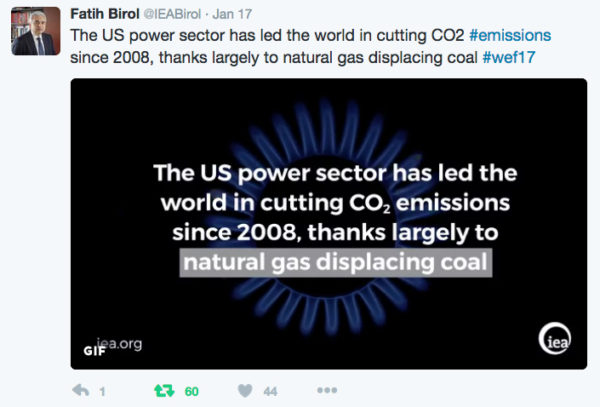United States on verge of becoming net energy exporter
United States leads in GHG reduction due to replacing coal with natural gas – Fatih Birol, IEA
by Seth Whitehead, EnergyInDepth
EIA has again upwardly revised its U.S. crude oil production projections, forecasting production will reach 9.53 million barrels per day (MMbpd) in 2018 — which would be the highest U.S. output since 1970.
EIA’s latest projections from its monthly Short-Term Energy Outlook is based largely on the fact that the U.S. rig count has climbed to its highest level since October 2015, which was just before the oil price slump began. Baker Hughes reported another 17 rigs were added last week for a total of 583 nationwide.
EIA’s revised projection for 2018 marks a 230,000 MMbpd increase from its previous forecast, as domestic producers continue to respond to the OPEC output cuts that have lifted crude prices well over $50 per barrel.
— Original Post, Jan. 20, 2017 —
Though often confused due to their similar acronyms, the International Energy Agency (IEA) and U.S. Energy Information Administration (EIA) are separate entities whose respective views on energy are often very different. But each agency’s most recent oil and gas forecasts couldn’t agree more — both conclude the 2017 outlook for shale development is very bright.
In an oil production outlook released Thursday, IEA forecasts U.S. production rising by 320,000 barrels per day this year, reversing course just weeks after predicting only marginal increases. EIA also now predicts U.S. oil and natural gas production will rise significantly in 2017 after recently forecasting modest production increases.
The reasons for each agency’s upwardly revised outlooks are similar as well.
‘Leaner and Fitter’ U.S. Shale
Not only does IEA attribute its revised outlook to the price rebound brought on by the recent OPEC production deal, it also credits greater U.S. shale efficiency, stating in a report released Thursday that,
“… Recent reports tell us that the productivity of shale activity has improved in leaps and bounds. Whether it be shorter drilling times or larger amounts of oil produced per well, there is no doubt that US shale industry has emerged from the $30/bbl oil world we lived in a year ago much leaner and fitter.”
IEA reports that oil production per rig has jumped 39 percent in the Bakken, 41 percent in the Permian and 26 percent in the Eagle Ford shale plays, due in large part to “improved well completion techniques, longer lateral wells, and the use of more proppants (that) have increased recovery estimates.”
EIA has upwardly revised its production forecast for basically the same reasons, as its latest Short-Term Energy Outlook explains,
“The upward revision largely reflects assumptions of higher drilling activity, drilling efficiency, and well-level productivity than assumed in previous forecasts.”
As the following J.P. Morgan graphic from a recent Business Insider article illustrates, these improvements in efficiency and innovation have dramatically lowered “break even” thresholds in several shale plays, each of which is now below $40 per barrel.
This recent J.P. Morgan graphic from a Business Insider article shows how drastically wellhead “breakeven” oil prices have fallen since 2013.
This is why IEA Executive Director Fatih Birol is quite confident that the current price environment is more than adequate enough to lead to a full-on launch of the Shale Revolution, Version 2.0. As he told Bloomberg Markets this week,
“I think U.S. shale-oil production will definitely react strongly. We see all the first indications. The number of rigs, the activity is increasing. Last year we had seen a decline and in the shale oil production in the United States and this year I believe the trend will be reversing…”
“At $50, $55, we’ve already seen a lot of activity. U.S. oil production will continue to increase in significant terms.”
Indeed, U.S. crude production rose to 8.95 million barrels a day in the first week of January, the highest level since April. Total U.S. natural gas production is also forecast by the EIA to increase in February for a third month in four to 48 billion cubic feet per day (bcfd). Oil rig counts are up 65 percent from lowest levels in May, while natural gas rigs are up 68 percent, with more than half of this activity taking place in the booming Permian Basin.
And oilprice.com reported this week that for the first time since September 2014, U.S. oil and gas extraction and support services jobs increased by 3,300 in November, according to the U.S. Bureau of Labor Statistics (BLS) data.
These developments have prompted the EIA to forecast that U.S. oil production will rise through 2017 to nine million barrels per day (mmbd) and 9.3 mmbd in 2018. EIA also forecasts dry natural gas production will increases by an average of 1.4 billion cubic feet per day (Bcf/d) in 2017 and by 2.8 Bcf/d in 2018, bouncing back from its first annual production decline since 2005.
As Reuters reported this week, the EIA’s latest drilling productivity report finds U.S. shale production is expected to snap a three-month production decline next month, as the following EIA chart illustrates.
 EIA data also shows producers drilled 712 wells and completed 545 more wells in the biggest shale basins in December, leaving total drilled but uncompleted wells up 167 at 5,379, the most since April. Again, this activity has been driven largely by the Permian Basin, as production from that play alone is set to rise by 53,000 bpd to 2.18 million bpd.
EIA data also shows producers drilled 712 wells and completed 545 more wells in the biggest shale basins in December, leaving total drilled but uncompleted wells up 167 at 5,379, the most since April. Again, this activity has been driven largely by the Permian Basin, as production from that play alone is set to rise by 53,000 bpd to 2.18 million bpd.
All of this promising production news considered, it’s not all that surprising that EIA also reported in its 2017 Annual Energy Outlook released this month that the U.S. will soon become a net energy exporter.
GHG’s still expected to fall
Not to be forgotten in all of this good news from the EIA and IEA regarding shale production activity is the fact that U.S. greenhouse gas emissions continue to fall — and both agencies credit shale gas for the declines.
EIA recently reported that energy-related carbon dioxide (CO2) emissions fell to their lowest levels since 1991 in 2016, and EIA administrator Adam Sieminski told the Washington Examinerlast March,
“The drop in CO2 emissions is largely the result of low natural gas prices, which have contributed to natural gas displacing a large amount of coal used for electricity generation.”
Case in point: EIA reported this week that natural gas officially surpassed coal as the main source for electrical generation in 2016 — the first time ever that a fuel other than coal supplied the bulk of the nation’s power on an annual basis.
Not coincidently, EIA also reported this week that carbon emissions from the transportation sector exceeded CO2 emissions from the electric power sector from October 2015 to September 2016 (see EIA graphic below), marking the first time that transportation carbon emissions have regularly surpassed electric power CO2 emissions since the late 1970s.

These developments simply would not be possible without abundant and affordable natural gas, which is why IEA credited natural gas for U.S. energy-related CO2 emissions falling 2 percent in 2015. As a press release from last March stated,
“In the United States, emissions declined by 2% (in 2015), as a large switch from coal to natural gas use in electricity generation took place.”
Birol even recently tweeted,

As former President Barack Obama recently noted, the U.S. is experiencing “the first sustained period of rapid GHG emissions reductions and simultaneous economic growth on record.” He also said, “This ‘decoupling’ of energy sector emissions and economic growth should put to rest the argument that combatting climate change requires accepting lower growth or a lower standard of living” and that the current trend “cannot be understated.”
There is little question that these once mutually exclusive trends have been driven by the shale revolution. And fortunately, the EIA and IEA agree that the outlook for both of these trends continuing in 2017 is very bright thanks to the expected resurgence in shale development.












